- Home
- Jared Diamond
Collapse: How Societies Choose to Fail or Succeed Page 19
Collapse: How Societies Choose to Fail or Succeed Read online
Page 19
At least three alternative types of agriculture emerged, all involving different solutions to the Southwest’s fundamental problem: how to obtain enough water to grow crops in an environment most of which has rainfall so low and unpredictable that little or no farming is practiced there today. One of the three solutions consisted of so-called dryland agriculture, which meant relying on rainfall at the higher elevations where there really was enough rain to promote growth of crops in the fields on which the rain fell. A second solution did not depend on rain falling directly on the field, but instead was adopted in areas where the water table in the ground reached close enough to the surface that plant roots could extend down into the water table. That method was employed in canyon bottoms with intermittent or permanent streams and a shallow alluvial groundwater table, such as in Chaco Canyon. The third solution, practiced especially by the Hohokam and also at Chaco Canyon, consisted of collecting water runoff in ditches or canals to irrigate fields.
While the methods used in the Southwest to obtain enough water to grow crops were variants on those three types, people experimented in different locations with alternative strategies for applying those methods. The experiments lasted for almost a thousand years, and many of them succeeded for centuries, but eventually all except one succumbed to environmental problems caused by human impact or climate change. Each alternative involved different risks.
One strategy was to live at higher elevations where rainfall was higher, as did the Mogollon, the people at Mesa Verde, and the people of the early agricultural phase known as the Pueblo I phase. But that carried the risk that it is cooler at high than at low elevations, and in an especially cool year it might be too cold to grow crops at all. An opposite extreme was to farm at the warmer low elevations, but there the rainfall is insufficient for dryland agriculture. The Hohokam got around that problem by constructing the most extensive irrigation system in the Americas outside Peru, with hundreds of miles of secondary canals branching off a main canal 12 miles long, 16 feet deep, and 80 feet wide. But irrigation entailed the risk that human cutting of ditches and canals could lead to sudden heavy water runoff from rainstorms digging further down into the ditches and canals and incising deep channels called arroyos, in which the water level would drop below the field level, making irrigation impossible for people without pumps. Also, irrigation poses the danger that especially heavy rains or floods could wash away the dams and channels, as may indeed eventually have happened to the Hohokam.
Another, more conservative, strategy was to plant crops only in areas with reliable springs and groundwater tables. That was the solution initially adopted by the Mimbres, and by people in the farming phase known as Pueblo II at Chaco Canyon. However, it then became dangerously tempting to expand agriculture, in wet decades with favorable growing conditions, into marginal areas with less reliable springs or groundwater. The population multiplying in those marginal areas might then find itself unable to grow crops and starving when the unpredictable climate turned dry again. That fate actually befell the Mimbres, who started by safely farming the floodplain and then began to farm adjacent land above the floodplain as their population came to saturate the floodplain’s capacity to support it. They got away with their gamble during a wet climate phase, when they were able to obtain half of their food requirements outside the floodplain. However, when drought conditions returned, that gamble left them with a population double what the floodplain could support, and Mimbres society collapsed suddenly under the stress.
Still another solution was to occupy an area for only a few decades, until the area’s soil and game became exhausted, then to move on to another area. That method worked when people were living at low population densities, so that there were lots of unoccupied areas to which to move, and so that each occupied area could be left unoccupied again for sufficiently long after occupation that its vegetation and soil nutrients had time to recover. Most southwestern archaeological sites were indeed inhabited for only a few decades, even though our attention today is drawn to a few big sites that were inhabited continuously for several centuries, such as Pueblo Bonito in Chaco Canyon. However, the method of shifting sites after a short occupation became impossible at high population densities, when people filled up the whole landscape and there was nowhere left empty to move to.
One more strategy was to plant crops at many sites even though rainfall is locally unpredictable, and then to harvest crops at whichever sites did get enough rain to produce a good harvest, and to redistribute some of that harvest to the people still living at all the sites that didn’t happen to receive enough rain that year. That was one of the solutions eventually adopted at Chaco Canyon. But it involved the risk that redistribution required a complex political and social system to integrate activities between different sites, and that lots of people then ended up starving when that complex system collapsed.
The remaining strategy was to plant crops and live near permanent or dependable sources of water, but on landscape benches above the main floodways, so as to avoid the risk of a heavy flood washing out fields and villages; and to practice a diverse economy, exploiting ecologically diverse zones, so that each settlement would be self-sufficient. That solution, adopted by people whose descendants live today in the Southwest’s Hopi and Zuni Pueblos, has succeeded for more than a thousand years. Some modern Hopis and Zunis, looking at the extravagance of American society around them, shake their heads and say, “We were here long before you came, and we expect still to be here long after you too are gone.”
All of these alternative solutions face a similar overarching risk: that a series of good years, with adequate rainfall or with sufficiently shallow groundwater tables, may result in population growth, resulting in turn in society becoming increasingly complex and interdependent and no longer locally self-sufficient. Such a society then cannot cope with, and rebuild itself after, a series of bad years that a less populous, less interdependent, more self-sufficient society had previously been able to cope with. As we shall see, precisely that dilemma ended Anasazi settlement of Long House Valley, and perhaps other areas as well.
The most intensively studied abandonment was of the most spectacular and largest set of sites, the Anasazi sites in Chaco Canyon of northwestern New Mexico. Chaco Anasazi society flourished from about A.D. 600 for more than five centuries, until it disappeared some time between 1150 and 1200. It was a complexly organized, geographically extensive, regionally integrated society that erected the largest buildings in pre-Columbian North America. Even more than the barren treeless landscape of Easter Island, the barren treeless landscape of Chaco Canyon today, with its deep-cut arroyos and sparse low vegetation of salt-tolerant bushes, astonishes us, because the canyon is now completely uninhabited except for a few National Park Service rangers’ houses. Why would anyone have built an advanced city in that wasteland, and why, having gone to all that work of building it, did they then abandon it?
When Native American farmers moved into the Chaco Canyon area around A.D. 600, they initially lived in underground pit houses, as did other contemporary Native Americans in the Southwest. Around A.D. 700 the Chaco Anasazi, out of contact with Native American societies building structures of stone a thousand miles to the south in Mexico, independently invented techniques of stone construction and eventually adopted rubble cores with veneers of cut stone facing (Plate 11). Initially, those structures were only one story high, but around A.D. 920 what eventually became the largest Chacoan site of Pueblo Bonito went up to two stories, then over the next two centuries rose to five or six stories with 600 rooms whose roof supports were logs up to 16 feet long and weighing up to 700 pounds.
Why, out of all the Anasazi sites, was it at Chaco Canyon that construction techniques and political and societal complexity reached their apogee? Likely reasons are some environmental advantages of Chaco Canyon, which initially represented a favorable environmental oasis within northwestern New Mexico. The narrow canyon caught rain runoff from many side-channels
and a large upland area, which resulted in high alluvial groundwater levels permitting farming independent of local rainfall in some areas, and also high rates of soil renewal from the runoff. The large habitable area in the canyon and within 50 miles of it could support a relatively high population for such a dry environment. The Chaco region has a high diversity of useful wild plant and animal species, and a relatively low elevation that provides a long growing season for crops. At first, nearby pinyon and juniper woodlands provided the construction logs and firewood. The earliest roof beams identified by their tree rings, and still well preserved in the Southwest’s dry climate, are of locally available pinyon pines, and firewood remains in early hearths are of locally available pinyon and juniper. Anasazi diets depended heavily on growing corn, plus some squash and beans, but early archaeological levels also show much consumption of wild plants such as pinyon nuts (75% protein), and much hunting of deer.
All those natural advantages of Chaco Canyon were balanced by two major disadvantages resulting from the Southwest’s environmental fragility. One involved problems of water management. Initially, rain runoff would have been as a broad sheet over the flat canyon bottom, permitting floodplain agriculture watered both by the runoff and by the high alluvial groundwater table. When the Anasazi began diverting water into channels for irrigation, the concentration of water runoff in the channels and the clearing of vegetation for agriculture, combined with natural processes, resulted around A.D. 900 in the cutting of deep arroyos in which the water level was below field levels, thereby making irrigation agriculture and also agriculture based on groundwater impossible until the arroyos filled up again. Such arroyo-cutting can develop surprisingly suddenly. For example, at the Arizona city of Tucson in the late 1880s, American settlers excavated a so-called intercept ditch to intercept the shallow groundwater table and divert its water downstream onto the floodplain. Unfortunately, floods from heavy rains in the summer of 1890 cut into the head of that ditch, starting an arroyo that within a mere three days extended itself for a distance of six miles upstream, leaving an incised and agriculturally useless floodplain near Tucson. Early Southwest Native American societies probably attempted similar intercept ditches, with similar results. The Chaco Anasazi dealt with that problem of arroyos in the canyon in several ways: by building dams inside side-canyons above the elevation of the main canyon to store rainwater; by laying out field systems that that rainwater could irrigate; by storing rainwater coming down over the tops of the cliffs rimming the canyon’s north wall between each pair of side-canyons; and by building a rock dam across the main canyon.
The other major environmental problem besides water management involved deforestation, as revealed by the method of packrat midden analysis. For those of you who (like me until some years ago) have never seen packrats, don’t know what their middens are, and can’t possibly imagine their relevance to Anasazi prehistory, here is a quick crash course in midden analysis. In 1849, hungry gold miners crossing the Nevada desert noticed some glistening balls of a candy-like substance on a cliff, licked or ate the balls, and discovered them to be sweet-tasting, but then they developed nausea. Eventually it was realized that the balls were hardened deposits made by small rodents, called packrats, that protect themselves by building nests of sticks, plant fragments, and mammal dung gathered in the vicinity, plus food remains, discarded bones, and their own feces. Not being toilet-trained, the rats urinate in their nests, and sugar and other substances crystallize from their urine as it dries out, cementing the midden to a brick-like consistency. In effect, the hungry gold miners were eating dried rat urine laced with rat feces and rat garbage.
Naturally, to save themselves work and to minimize their risk of being grabbed by a predator while out of the nest, packrats gather vegetation within just a few dozen yards of the nest. After a few decades the rats’ progeny abandon their midden and move on to build a new nest, while the crystallized urine prevents the material in the old midden from decaying. By identifying the remains of the dozens of urine-encrusted plant species in a midden, paleobotanists can reconstruct a snapshot of the vegetation growing near the midden at the time that the rats were accumulating it, while zoologists can reconstruct something of the fauna from the insect and vertebrate remains. In effect, a packrat midden is a paleontologist’s dream: a time capsule preserving a sample of the local vegetation, gathered within a few dozen yards of the spot within a period of a few decades, at a date fixed by radiocarbon-dating the midden.
In 1975 paleoecologist Julio Betancourt happened to visit Chaco Canyon while driving through New Mexico as a tourist. Looking down on the treeless landscape around Pueblo Bonito, he thought to himself, “This place looks like beat-up Mongolian steppe; where did those people get their timber and firewood?” Archaeologists studying the ruins had been asking themselves the same question. In a moment of inspiration three years later, when a friend asked him for completely unrelated reasons to write a grant proposal to study packrat middens, Julio recalled his first impression of Pueblo Bonito. A quick phone call to midden expert Tom Van Devender established that Tom had already collected a few middens at the National Park Service campground near Pueblo Bonito. Almost all of them had proved to contain needles of pinyon pines, which don’t grow anywhere within miles today but which had nevertheless somehow furnished the roof beams for early phases of Pueblo Bonito’s construction, as well as furnishing much of the charcoal found in hearths and trash middens. Julio and Tom realized that those must be old middens from a time when pines did grow nearby, but they had no idea how old: they thought perhaps just a century or so. Hence they submitted samples of those middens for radiocarbon dating. When the dates came back from the radiocarbon laboratory, Julio and Tom were astonished to learn that many of the middens were over a thousand years old.
That serendipitous observation triggered an explosion of packrat midden studies. Today we know that middens decay extremely slowly in the Southwest’s dry climate. If protected from the elements under an overhang or inside a cave, middens can last 40,000 years, far longer than anyone would have dared to guess. As Julio showed me my first packrat midden near the Chaco Anasazi site of Kin Kletso, I stood in awe at the thought that that apparently fresh-looking nest might have been built at a time when mammoths, giant ground sloths, American lions, and other extinct Ice Age mammals were still living in the territory of the modern U.S.
In the Chaco Canyon area Julio went on to collect and radiocarbon-date 50 middens, whose dates turned out to encompass the entire period of the rise and fall of Anasazi civilization, from A.D. 600 to 1200. In this way Julio was able to reconstruct vegetational changes in Chaco Canyon throughout the history of Anasazi occupation. Those midden studies identified deforestation as the other one (besides water management) of the two major environmental problems caused by the growing population that had developed in Chaco Canyon by around A.D. 1000. Middens before that date still incorporated pinyon pine and juniper needles, like the first midden that Julio had analyzed, and like the midden that he showed me. Hence Chaco Anasazi settlements were initially constructed in a pinyon/juniper woodland unlike the present treeless landscape but convenient for obtaining firewood and construction timber nearby. However, middens dated after A.D. 1000 lacked pinyon and juniper, showing that the woodland had then become completely destroyed and the site had achieved its present treeless appearance. The reason why Chaco Canyon became deforested so quickly is the same as the reason that I discussed in Chapter 2 to explain why Easter Island and other dry Pacific islands settled by people were more likely to end up deforested than were wet islands: in a dry climate, the rate of tree regrowth on logged land may be too slow to keep up with the rate of logging.
The loss of the woodland not only eliminated pinyon nuts as a local food supply but also forced Chaco residents to find a different timber source for their construction needs, as shown by the complete disappearance of pinyon beams from Chaco architecture. Chacoans coped by going far afield to forests of ponderosa
pine, spruce, and fir trees, growing in mountains up to 50 miles away at elevations several thousand feet higher than Chaco Canyon. With no draft animals available, about 200,000 logs weighing each up to 700 pounds were carried down the mountains and over that distance to Chaco Canyon by human muscle power alone.
A recent study by Julio’s student Nathan English, working in collaboration with Julio, Jeff Dean, and Jay Quade, identified more exactly where the big spruce and fir logs came from. There are three potential sources of them in the Chaco area, growing at high elevations on three mountain ranges nearly equidistant from the canyon: the Chuska, San Mateo, and San Pedro Mountains. From which of those mountains did the Chaco Anasazi actually get their conifers? Trees from the three mountain ranges belong to the same species and look identical to each other. As a diagnostic signature, Nathan used isotopes of strontium, an element chemically very similar to calcium and hence incorporated along with calcium into plants and animals. Strontium exists as alternative forms (isotopes) differing slightly in atomic weight, of which strontium-87 and strontium-86 are commonest in nature. But the strontium-87/strontium 86 ratio varies with rock age and rock rubidium content, because strontium is produced by radioactive decay of a rubidium isotope. It turned out that living conifers from the three mountain ranges proved to be clearly separated by their strontium-87/ strontium-86 ratios, with no overlap at all. From six Chaco ruins, Nathan sampled 52 conifer logs selected on the basis of their tree rings to have been felled at dates ranging from A.D. 974 to 1104. The result he obtained was that two-thirds of the logs could be traced by their strontium ratios to the Chuska Mountains, one-third to the San Mateo Mountains, and none at all to the San Pedro Mountains. In some cases a given Chaco building incorporated logs from both mountain ranges in the same year, or used logs from one mountain in one year and from the other mountain in another year, while the same mountain furnished logs to several different buildings in the same year. Thus, we have here unequivocal evidence of a well-organized, long-distance supply network for the Anasazi capital of Chaco Canyon.

 Why Is Sex Fun?: The Evolution of Human Sexuality
Why Is Sex Fun?: The Evolution of Human Sexuality Guns, Germs, and Steel: The Fates of Human Societies
Guns, Germs, and Steel: The Fates of Human Societies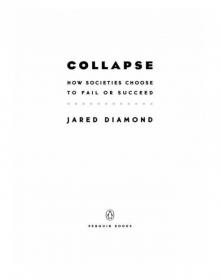 Collapse: How Societies Choose to Fail or Succeed
Collapse: How Societies Choose to Fail or Succeed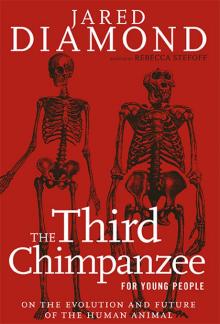 The Third Chimpanzee: The Evolution and Future of the Human Animal
The Third Chimpanzee: The Evolution and Future of the Human Animal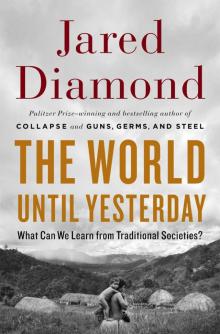 The World Until Yesterday: What Can We Learn From Traditional Societies?
The World Until Yesterday: What Can We Learn From Traditional Societies?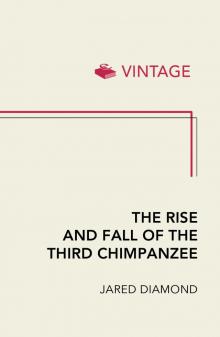 The Rise and Fall of the Third Chimpanzee
The Rise and Fall of the Third Chimpanzee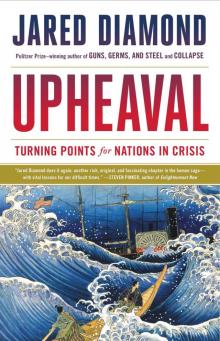 Upheaval: Turning Points for Nations in Crisis
Upheaval: Turning Points for Nations in Crisis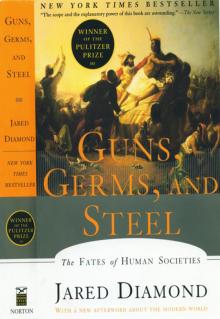 Guns, Germs, and Steel
Guns, Germs, and Steel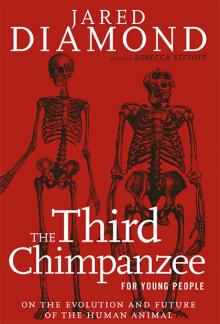 The Third Chimpanzee for Young People
The Third Chimpanzee for Young People Why Is Sex Fun?
Why Is Sex Fun?